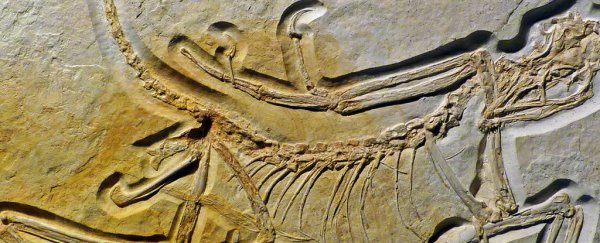The world's earliest known bird genus, Archaeopteryx, is only understood thanks to a small handful of fossils.
A new find from Northern Bavaria is the oldest one yet, harking back 150 million years - and it may also shed some light on how the animal evolved.
Fossils of the bird were first discovered in the 1860s, and to date all Archaeopteryx fossil records have emerged from the same place: the valley of the Altmühl river in southern Germany. During the Jurassic, the area was an extensive archipelago.
This, too, was where the most recent Archaeopteryx fossil was found in 2010 - exceptionally well preserved remains, although not quite as detailed as the 1874 Berlin specimen, so detailed the rock even contained impressions of its plumage.
Now researchers from Ludwig-Maximilians-Universitaet in Munich have analysed the specimen, and found some differences from the other known fossils - a curious result indeed.
 (O. Rauhut, LMU)
(O. Rauhut, LMU)
Determining the fossil's status as an Archaeopteryx, however, has been a tremendously painstaking order of business.
Several specimens reported as Archaeopteryx over the years have turned out to be other species.
For instance, the very first Archaeopteryx fossil, the Haarlem specimen found in 1855, was reclassified just last month. It was, palaeontologists Christian Foth and Oliver Rauhut concluded, closer to the Chinese bird-like dinosaur Anchiornis than Archaeopteryx.
The species has also come under fire, with scientists in the 1980s challenging it as a hoax.
Rauhut, a professor in the Department for Earth and Environmental Sciences, also led the research on the newest specimen, finding that it predated any of the previous discoveries - and that the Jurassic species existed much longer than previously thought.
"Specimens of Archaeopteryx are now known from three distinct rock units, which together cover a period of approximately 1 million years," Rauhut said.
As the oldest example of Archaeopteryx, the fossil has features similar to those of predatory non-avian Theropod dinosaurs such as Tyrannosaurus rex and Velociraptor, to which it is related.
But it also has a lot of differing features, which allowed the team to develop a diagnostic key to help more accurately identify Archaeopteryx, should more specimens be found in the future.
And it's not exactly the same as its later Archaeopteryx relatives, either. Notably, Rauhut and his team found that the teeth lining the crow-sized birds' beaks differed in pattern, and no two Archaeopteryx specimens were alike.
Because the birds used to live on an archipelago, this suggests that, like Darwin's finches, they may have evolved to suit different living conditions on different islands - with a very strong identifier being their beaks.
"The high degree of variation in the teeth is particularly striking - none of the specimens shows the same pattern of dentition as any other, which could reflect differences in diet," Rauhut said.
"It is even conceivable that this primeval bird genus might, in a similar fashion, have diversified into several specialised forms on the islands of the Solnhofener Archipelago.
"In that case, the Archaeopteryx fossils could represent a species flock, a Jurassic analog of Darwin's finches."
The paper can be read in full in the journal PeerJ.
